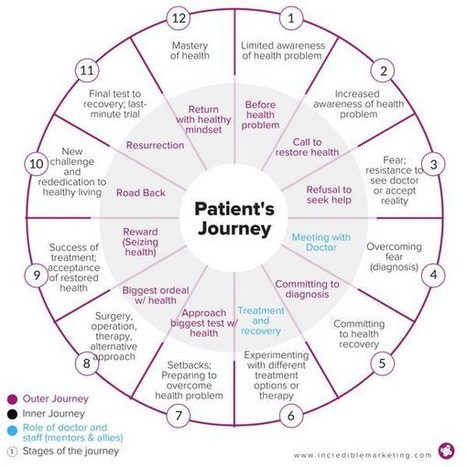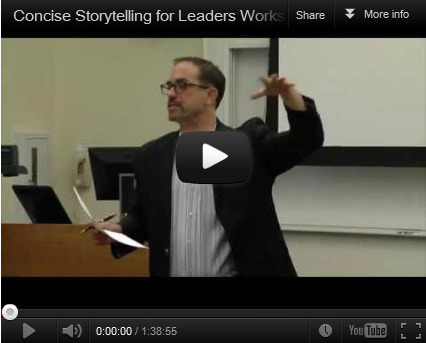 Your new post is loading...
 Your new post is loading...
"Stories are irresistible. We can’t help but pay attention to them. Which is why you’re going to trade in your patient testimonials (the ones filled with statements and facts) for patient stories that make your patients the heroes of their own epics." Read the full article to find out how tell your patients stories by: - breaking down each stage of the hero's journey framework to develop a transformational story
- adapting each stage of the hero's journey into a patient’s journey and pepper your narrative with meaning using five archetypal plots and morals:
- The Quest
- Overcoming the Monster
- Voyage and Return
- Rags to Riches
- Rebirth
- using the real life examples and downloadable patient interview questionnaires as a guide
Visual storytelling. A professional food stylist and photographer offers tips for taking photos of food.
Stories bypass the judgmental, intellectualizing prefrontal lobes of the brain, the source of our conscious decision-making, and tap directly into the older and more primitive limbic areas of the brain, where often unconscious visceral choice and attachment originate. In my 18 years of facilitating story workshops among every possible population, including groups that were in extreme conflict, I've seen the transformational results that happen when minds are in sync. And I have come to be able to identify the exact moment when it happens. There's a palpable shift and softening in energy, a quiet and stillness settles over the group, or the couple, or the person across from me, which I've learned to accept as enrapt attention, full Presence -- in creative terms, Flow. This article demonstrates how story reaches beneath the thinking mind to the feeling one, from one inner life to another inner life, where we are all human beings together standing on the common ground of life. Included are 7 steps on how to develop a Connector story.
Becky Higgins gives ideas for documenting daily life using photos.
For some people, “visual storytelling” means photographs. For others, it means film or video. An epic movie such as the Lord of the Rings trilogy may spring to mind — and few would disagree with that as a fine example of visual storytelling. In journalism writing classes, students learn: “Show, don’t tell.” When we provide a visual, that maxim carries even more weight. The less text or audio that an image needs to be understood, the better it is. Some photojournalists think it’s best to let photos stand alone. Some like to publish their portfolios with no captions at all. This is a pet peeve of mine: I want to know more. I always want to know who, when, and where. Always! For me this is part of authentication, which is part of what makes it journalism and not interpretive art. A photo without a caption is not journalism.
Regular contributor Thaler Pekar helps smart leaders and their organizations find, develop, and share the stories and organizational narratives that can rally critical support. Here are some tips on how you can elicit stories about your organization from colleagues, board members, donors, clients, grantees, and others.
If you are trying to figure out how to write an autobiography, you have probably long since passed the step of deciding whether or not your life is worth writing about. You know you have a story to tell. You know it’s worth telling. And, whether you are doing it for your family and children or for the public at large, you are interested in sharing it. So the next question is, “Where do I start?” The easiest answer would be at the beginning. But the beginning is not always so simple to identify—your life is a story, whether you realize it or not, and to write your autobiography, you have to do a little work on discovering that story. Here are some exercises that will help ...
Most audiences do not want to be preached to outside of the church. However, it is sometimes easy to fall into preaching especially when you are very passionate about your message. Below are three guidelines you can follow to prevent destroying your speech due to preaching.
One of the fundamental goals of content marketing, of all advertising, is to create fans that will spread your stories for free, lowering your marketing expenses. Content that appeals to our social nature is ideal for storytelling, so find the stories about your employees, your company, your services and your products and tell them! Below are five tips to help you improve your storytelling.
All writers need research to make their worlds resonate for the reader; to add details that make their stories believable, however fantastic. This is what hooks and holds readers. The secret is to identify what you need to know, where to find verifiable information … and when to stop.
Business school communication lecturer JD Schramm helps alumni develop the art and science of tight story-telling for social impact in this video lecture "Concise Storytelling for Leaders Workshop". In this video you will you learn his habits of concise storytelling: - Skip the preamble - “Follow Goldilocks” – that is, to think carefully about how much detail to include; not too much and not too little. - Connect with individuals - As in music, silence is effective - Don’t read or memorize the manuscript, nor try to speak off-the-cuff - Use PowerPoint wisely - Know your AIM: audience, intent, and message - Do use personal anecdotes, self-deprecating humor, and accessible language It's long, but see it as a free and complete storytelling course.
|
When you hear, "tell me a story," does your mind suddenly go blank? Don't panic. Do you know that the best corporate leaders liven a business presentation with a story, but you don't know how? Don't worry. The good news is you're already a natural storyteller! Surprised? You shouldn't be. It's built right into our genetic code. How do you go from being a "natural" storyteller to being a good one? Here are ten tips to get you started...
Yes, great storytellers are great writers. They understand narrative structure, setting, how to grab attention, how to humanize and build tension and ultimately, how to bring it all full circle or provide a call to action. In our digital world, great storytellers possess the technical skills to build and manage a blog, shoot photos, record audio, create good videos and maximize use of our favorite social media channels. That aside, stories first need to be discovered and explored. Great stories also typically require time to evolve and develop in order to properly match a storyteller’s vision. So what’s the super secret to drumming up a great story? Take a walk and explore.
Personal writing needs good story-telling. When you write your personal story make sure it really is personal then focus on what the story is, why you’re telling it and what reaction you want. Storytellers need to remember these personal writing tips and include them in every single story, whether we’re telling it orally, or writing it to share on our blogs or elsewhere.
One of my favorite activities with my children is telling bedtime stories. It’s a fun time for us to connect and use our imaginations together. It’s also a way to help my children build their own storytelling skills. If you’re new to bedtime story telling, I’ve got some tricks to help keep your stories on track and make them interactive by giving your kids the opportunity to tell them with you. My background is in improv comedy where I made up a lot of stories on the spot. One of the tools I’ve used to teach storytelling to improv students is the Story Spine and it works great for bedtime stories. The Story Spine was created by Kenn Adams in his book How to Improvise a Full Length Play.
Another blogger inspired me to create an A-Z list of highlights of story finds for the year. Strictly speaking, not all of these are finds. Some are my own creations or initiatives. Others are practitioners I’ve highlighted in the past who’ve been resurgent in the last year. Still others are simply tributes. But they represent some of the most notable content about applied storytelling from 2011.
If you want to tell better stories, take a few moments to identify the emotions of your characters and especially the change of emotion. Then make sure your audience can see it and more importantly feel it.
Five years after Youtube’s birth there’s probably not a newsroom in the land that isn’t trying to do video journalism in some way or another. I say ‘trying’ because, as you’ll probably have seen, the vast amount of online video produced just doesn’t cut it. It’s long, boring, technically poor – and amateurish. This is a big shame because online video – done well – has the power to be an art form, to touch people, to make them understand something, to make them care.
You know you have it in you to write. You can see the character’s faces and hear their voices. The names you’ve christened them with are as familiar to you as a close family member. You even have a few scenes rolling around in your head that excite you. But what do you do when you’re missing the most important element to bring it all together? What do you do when you just don’t have a story?
This chapter is about the many ways to tell a story and serves as an introduction to videojournalism as it relates to nonfiction storytelling. Videojournalism is not reality TV; it is not traditional front-page news articles. The secret to good videojournalism lies in finding and telling well-shaped, powerful stories in multimedia presentation. Most successful stories have a main character. There are many ways to tell a story. You can do it chronologically— start at the beginning and end at the end. Or, you can disclose the most important piece of information first, and then reveal the rest of the story, bit by bit. You can tell the story through the eyes of your characters, or from the viewpoint of an outsider. As a videojournalist, you get to decide how you will tell your story—in a way that will compel your audience to stop, look, and listen.
You’ve probably heard me say it before…when you find your story, it makes all the difference. Here’s why...
As a communications coach, I've developed a four-step exercise that will work for any company or product. You must simply answer the following four questions in no more than two sentences. By keeping each answer brief, you will develop a succinct story that should take no more than 60 seconds.
|



 Your new post is loading...
Your new post is loading...



























What a great resource! I'm only sad I didn't discover it when it was first published. Such a time saver to have a templated format for your storytelling toolkit. Even if you're not working with patients or testimonials, you have many hero based stories you can tell. Use the guide and format that Drew has so generously shared to create your own templates focused on your client type or employee base.
I really like how he summed up when to use which plot.
"To ensure you choose the right hero’s journey, identify the nature of the issue first. Then let your patients articulate their motivations. And then analyze the life lessons your patients gained from their journey. Last, choose the hero’s journey that most closely aligns with the given context."